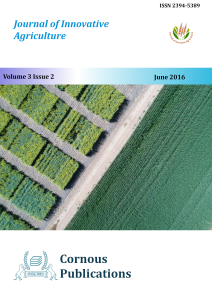Black gram (Urd bean) is an important pulse crop preferred in South India due to its daily dietary component. Often the productivity is limited by environmental stresses particularly of water, salinity and high temperature. Transitory or constantly high temperatures cause an array of morpho-anatomical, physiological and biochemical changes in plants, which affects the plant growth and development and may lead to a drastic reduction in economic yield. The adverse effects of heat stress can be mitigated by developing crop plants with improved thermo tolerance using various genetic approaches. A thorough understanding of physiological responses of plants to high temperature, mechanisms of heat tolerance and possible strategies for improving crop thermo tolerance is imperative. The sugar metabolism is an important parameter and understanding the thermo tolerance in terms of total carbohydrate and starch content might through light on genotypic variability. Among the nineteen black gram genotypes screened under controlled atmospheric studies have shown that VBG – 06 – 002 has shown promising for heat tolerance as the carbohydrate content in leaves and starch content in the grains was least affected by heat stress and deserve to be evaluated further. There were only 2.8 and 5.07 per cent reduction in the carbohydrate and starch content due to heat stress when compared other genotypes which have recorded more reduction in both parameters indicating genotypic superiority for heat stress. Based on the biochemical analysis, black gram genotype.
Bhendi (Abelmoschus esculentus L. Moench) is an important warm season vegetable crop cultivated in India. It is the world’s largest producer of vegetables next to China. Among the vegetables grown extensively, bhendi found an important place due to their significant nutritional value. Phyllosphere microbes often have a direct positive influence in altering plant surface properties, where they may be involved in the fixation of nitrogen, promoting the growth of plants, control of plant pathogens or the degradation of organic pollutants. The present study was undertaken the microbial population and Azospirillum population in the phyllosphere region of bhendi. Five Azospirillum isolates were isolated from Bhendi Phyllosphere viz., BAZ 1, BAZ 2, BAZ 3, BAZ 4 and BAZ 5 and five strains were characterized as Azospirillum brasilense. These strains were screened for their N2 fixing efficiency and IAA production.
An investigation on the induction of mutation in tuberose was carried out at the Department of Floriculture and Landscaping, TNAU, Coimbatore with the objective of examining the effect of chemical mutagens viz., Diethyl Sulphate (DES) @ 15, 20, 25 and 30 mM and Ethyl Methane Sulphonate (EMS) @ 30, 45, 60 and 75 mM on bulb sprouting, survival percentage and growth parameters. Lower doses (15 mM of DES and 30 mM of EMS) were found to favour bulb sprouting and growth parameters. In general, variations in floral characters were observed invariably in all the treatments except control. The LC50 values fixed for the chemical mutagens were 25 mM for DES and 60 mM for EMS. It was interesting to observe that lower doses of the mutagens had recorded higher values for morphological and floral parameters than untreated control.
The representative soil series of order Entisols, Inceptisols and Vertisols collected from agriculture college Kolhapur and different research stations of Sub-montane zone of Maharashtra were assessed for different forms of potassium and its distribution. The water soluble K, Exchangeable K, non-exchangeable K and lattice K contributed 0.23, 2.87, 8.97 and 87.81 per cent of total K, respectively. From the mean values, highest water soluble K, exchangeable K, non-exchangeable K, lattice K and total K were noticed in Vertisols followed by Inceptisols and Entisols. The water soluble k and exchangeable K were found higher in surface layer than sub-surface layer. There was no any specific trend noticed with respect to depth wise distribution of different forms of potassium. These representative soil series of Sub-montane zone of Maharashtra were categorized as medium to high in status for non-exchangeable K and low to moderate in status for total K.
The representative soil series of order Entisols, Inceptisols and Vertisols collected from agriculture college Kolhapur and different research stations of Sub-montane zone of Maharashtra were assessed for potassium release and fixation capacity. The K-fixation in different soils ranged from 78.80 mg kg-1 (Kurkum series of A.R.S., Vadgaon-Maval) to 276.40 mg kg-1 (Koregaon series of A.R.S., Karad). From the mean values, it was observed that Vertisols showed highest K fixation capacity followed by Inceptisols and Entisols. All the soil series were categorized as very low in step K except Koregaon series of A.R.S., Karad of Vertisols. The sub-surface horizon showed higher cumulative step K release than the surface horizon. The step K and constant rate K was highest in Vertisols followed by Inceptisols and Entisols.
